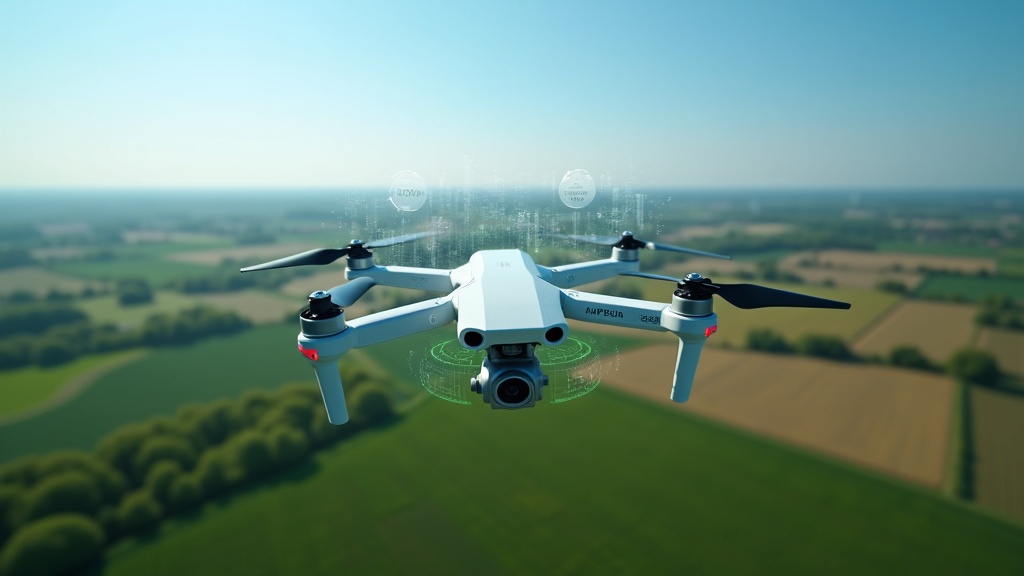Artificial intelligence and drone technology have teamed up to spark a tech glow-up. I see AI showing up just about everywhere in drone flight these days, making drones smarter, safer, and more capable than ever. Whether you’re a hobbyist, a creative filmmaker, or you work in areas like agriculture or infrastructure, AI is ready to take your drone experience to the next level. Let’s see how AI is shaking up the drone world and what you need to know to fly smarter, not harder.

AI-Powered Flight: What’s Changing in Drone Technology?
Drones have come a long way. Those early models were basically remote controlled toys with wobbly cameras. Now, with AI built in, drones can make on-the-spot decisions, avoid obstacles, and grab the exact shots you want with hardly any manual effort. This shift goes beyond just automation. Drones now handle and process data while flying, adapting to the world around them, giving you fewer crashes and wow-worthy results without much fuss.
The global drone market is growing fast. Research groups like Grand View Research estimate it’s already worth tens of billions of dollars, and AI is one of the main boosters for that trend. You’ll spot AI driven drones in all sorts of places: filmmaking, farming, package delivery, inspections, surveillance, mapping, and more. Companies and everyday people are seeing the perks of giving drones both brains and wings.
How AI Helps Drones See, Think, and React
AI isn’t magic, but it can sure feel like it. I’ve witnessed AI letting drones follow routes hands free, spot objects automatically, and even recognize people or animals. Here’s how AI gives drones a serious boost:
- Object Recognition: AI in drone cameras can spot cars, livestock, power lines, crops, and other objects as it flies. This is perfect for surveying land, inspecting buildings, or checking on wildlife.
- Autonomous Navigation: AI lets drones create and follow flight paths, avoid trees or towers, and reach their destination even if you lose connection for a while.
- Obstacle Avoidance: Onboard sensors use machine learning to recognize barriers and steer away. This cuts crashes and helps your drone survive day-to-day use.
- Data Processing Onboard: Some drones crunch data as they fly, so you spend less time waiting to transfer files when you’re done flying.
- Adaptive Flight Modes: Cool features like “Follow Me” or “Point of Interest” let your drone lock onto moving people or vehicles—all without tricky piloting skills.
Getting Started with AI Driven Drones
If you haven’t flown a drone that uses AI, you’re missing out. Getting started is easy, but I recommend checking a few things before you fly:
- User Friendly Flight Apps: Most top drones have apps that are simple to set up and use. Look for apps with step-by-step guides and built in safety alerts.
- Smart Sensors and Cameras: AI relies on good hardware. Choose drones that mention visual sensors and AI copilots for a real hands off flying experience.
- Cloud Connectivity: Some drones upload photos and data to the cloud instantly, making it simple to process or share files right away.
AI smooths the way for new pilots. You’ll spend less time fussing with controls and more time grabbing creative shots or gathering data for your projects.
Practical Ways AI Is Boosting Drone Flight
I’ve seen AI go way beyond eye catching tricks. Here’s where I think AI is making a real difference:
- Precision Agriculture: AI helps drones analyze crop health, spot irrigation issues, and flag invasive plants. Farmers get rapid, detailed updates for smart, quick decision making.
- Infrastructure Inspection: Drones can find cracks or rust on bridges, towers, and pipes. AI tags problem spots for workers to double-check, which speeds up repairs and keeps everyone safer.
- Search and Rescue: AI trained to spot body shapes or heat signatures can help find lost hikers or pets. Drones quickly cover wide spaces, letting crews react as soon as something is spotted.
- Surveying and Mapping: AI puts together hundreds of snapshots into clear 3D models. This shakes up construction, real estate, and environmental science by making mapping faster.
- Filmmaking: Creative pros love AI tracking for smooth, epic shots, even when filming fast-moving sports or wildlife scenes.
What to Watch Out for When Using AI in Drone Flight
AI drones offer a lot, but a few things are worth watching to get the most out of this technology:
- Data Privacy: Drones often record video and GPS details. Mind the privacy laws in your area, especially if you fly near neighborhoods or businesses.
- Dependence on Connectivity: Cloud AI does its best work with a strong internet signal. If you’re off the grid, check if your drone works offline, or if you’ll have to use only basic features.
- Battery Drain: AI can burn through batteries faster, so plan for possibly shorter flights. Extra batteries or a power bank can be a lifesaver.
- Updates and Maintenance: Drone software keeps evolving. Keeping your gear updated means your drone stays sharp and benefits from new safety tweaks.
- Learning Curve: Most AI drones are easy to fly, but learning all the cool modes and options takes a little time. Tutorials and open space flights are perfect for building up your skill.
Data Privacy
AI drones pick up a lot of personal info. Flying only in approved areas and respecting people’s privacy is a big deal—and it saves you trouble later. Stay on top of any local or national rules on recording, mapping, or business drone flights, especially in places like the EU or the US, where the rules can be tight.
Battery Life with AI Features
All those AI features use more energy, so drones may run down batteries faster than you think. More sensors and more data mean less time in the air. I always carry a backup battery, plan short missions, or choose a drone built for energy efficiency if I use AI features a lot.
Skill Development
AI makes drones more forgiving, but hands-on flight practice is still key. Experimenting with auto modes in safe, quiet spots helped me see how AI actually works—and what to do when something unexpected happens. Trying the “return home” and collision avoidance options in a safe spot will help you fly with more confidence.
Tips to Get the Most Out of AI Powered Drone Flight
To squeeze the best results from these smart drones, I stick to a handful of habits that make everything smoother:
Customize Flight Modes: Dig into your drone’s settings and shape things like follow distance, flight limits, and obstacle sensitivity. Tweaking these features will help you get top notch results for whatever you have in mind.
Review Flight Logs: Lots of drones log every flight detail. Checking these logs helps you spot patterns, fix small problems, or see why a shot didn’t work out.
Keep an Eye on Updates: Drone brands are always adding fresh AI features and fixes. Regularly updating your drone keeps it safe and in the loop.
Mix Manual and AI Controls: I keep my manual flying sharp just in case auto modes can’t handle a tricky landing or weird glitch. Switching between modes gives real confidence in your flying skills.
The Basics: Choosing Drones with Top AI Features
The best AI drone for you depends on how you plan to use it. Here are my top tips, plus samples of where AI really delivers:
- Beginners: Opt for drones with obstacle avoidance and built in stability. Even complete newbies can skip most crashes this way.
- Agriculture: Seek out AI models built to spot crop health. These scan acres of farmland in a short time—much faster than walking the fields.
- Surveyors: Drones packing lidar or auto-mapping nail 3D models that save time and boost accuracy.
- Filmmakers: Drones with AI subject tracking lock onto athletes or wildlife for intense, hands free filming.
Here’s a real-life example: I worked alongside a small business using AI drones to inspect rooftop solar panels. The drone spots, tags, and snaps pictures of each panel needing attention. No more risky climbing—and tons of time and effort saved compared to the old school way. That simply wasn’t possible before AI started doing the heavy lifting.
Frequently Asked Questions
Here are a few of the top questions I hear about AI and drones:
Question: How does AI make drones safer?
Answer: AI driven object detection and navigation help drones avoid obstacles and stick to their flight plans, even when unexpected things pop up.
Question: Do I need special training to fly an AI powered drone?
Answer: Most new models don’t require advanced skills. The learning curve is smoother than ever, but getting familiar with the features and practice flights will help you get the best out of your drone.
Question: Will AI replace skilled drone pilots?
Answer: Not totally. AI can handle the boring or repetitive parts, but humans still bring the creativity and quick thinking needed for tough or unique flying jobs.
AI and the Future of Drone Flight
AI has moved beyond being just a flashy add-on for drones. Real benefits are popping up for both rookies and pros in fields from mapping to filmmaking and more. AI lets drones fly smarter and handle more tasks, freeing up your time and stepping up what’s possible. I’m excited to see how this tech will shake up work, creative projects, and safety in the sky as it keeps evolving and spreading into every corner of drone flight.
